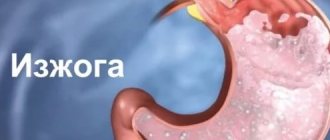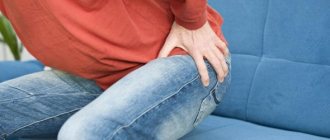Functional dyspepsia
Functional dyspepsia - for this diagnosis the following conditions are necessary:
- Symptoms of dyspepsia are constant, recurring, and last more than 12 weeks throughout the year.
- Upper gastrointestinal endoscopy does not reveal the organic diseases listed above.
- There is no irritable bowel syndrome (symptoms do not disappear after bowel movement and are not associated with changes in the nature of stool or its frequency).
Causes of functional dyspepsia
- excess production of hydrochloric acid;
- nutritional disorders (nutritional errors);
- taking certain medications;
- stress;
- infection of the gastric mucosa with a specific microorganism - Helicobacter pylori;
- disturbances in the motor function of the stomach and duodenum.
There are certain “alarm symptoms” that should alert the patient and the doctor, since they are not typical for functional dyspepsia:
- night pain;
- anorexia, vomiting;
- growth retardation in children;
- fever and joint pain;
- blood in stool;
- frequent epigastric pain of the same type, irradiation of pain.
The causes of dyspepsia are not fully understood. But it is known that the main one can be long-term poor nutrition with significant “distortions” in favor of certain food groups. In this case, fermentative, putrefactive and fatty dyspepsia are distinguished.
Symptoms of putrefactive dyspepsia
Conventionally, all manifestations of putrefactive dyspepsia can be divided into two groups. Dyspeptic symptoms:
- nausea, vomiting, belching;
- abdominal pain along the intestines;
- loose or pasty dark stools with a foul odor;
- the appearance of tenesmus (false urge to defecate);
- feeling of heaviness in the stomach;
- bloating and passing large amounts of intestinal gas.
Symptoms of general intoxication of the body:
- temperature rise to subfebrile levels (37 – 37.50C);
- headache and dizziness;
- weakness, lethargy;
- decreased appetite.
Putrefactive dyspepsia can develop acutely (for example, when overeating meat products). In this case, it can be eliminated quite quickly. But most often this is a chronic process that lasts for years and may indicate serious disorders of the digestive system.
Fermentative dyspepsia
Fermentation dyspepsia is associated with an excess of carbohydrates in the diet (sugar, honey, flour, sweet fruits, grapes, legumes, cabbage), coarse plant fiber, and fermented drinks (for example, kvass). One of the important causative factors is insufficiently thorough chewing of food. As a result, favorable conditions are created in the intestines for the development of microorganisms that support fermentation processes.
It is manifested by flatulence (excessive gas formation in the intestines), frequent passage of gases, increased peristalsis, rumbling in the abdomen, frequent loose, foamy, slightly colored stools with a sour odor. A scatological examination (study of stool samples) reveals an abundance of starch grains, fiber, and organic acids. Feces give an acidic reaction.
Putrid dyspepsia in children
The cause of putrefactive dyspepsia in children is most often the immaturity of the enzyme system. Violations can occur due to incorrect or untimely introduction of complementary foods or an excess of protein foods in the diet. The symptoms of the disease are practically no different from the manifestations of putrefactive dyspepsia in adults - loose stools with an unpleasant odor, colic and bloating. Babies are not always able to release gases on their own, and to alleviate their condition, it is necessary to use a gas outlet tube.
Young children can quickly become dehydrated as a result of diarrhea. They become lethargic, a white coating appears on the tongue, and skin turgor is reduced. To prevent fluid loss, you need to give enough water and reduce the number of milk feedings.
Fatty dyspepsia
Fatty dyspepsia (sometimes also called “soapy”) can be triggered by excessive consumption of indigestible refractory fats (pork, lamb).
The stool is usually light-colored, abundant, difficult to flush down the toilet, and has a “greasy” sheen. Coprology reveals large amounts of undigested fat, fatty acids and their insoluble salts. The stool gives a neutral or alkaline reaction.
Chronic dyspepsia is characterized by intermittent diarrhea and constipation. Often this reveals intolerance to certain types of food, “functional weakness” of the gastrointestinal tract.
Diagnosis of putrefactive dyspepsia
Diagnosing pathology is not difficult. The patient examination can be divided into several stages:
- interview with a doctor (complaints, nutritional patterns);
- examination (superficial palpation and auscultation of the abdomen);
- scatological examination of feces (the alkaline reaction of the material and the predominance of muscle fibers in it, and not mucus and formed elements - leukocytes and erythrocytes, as in inflammation, clearly indicates putrefactive dyspepsia);
- stool analysis for dysbacteriosis (predominance of opportunistic microflora in the material).
If putrefactive dyspepsia is acute and caused by banal overeating, such an examination is quite enough to make a diagnosis and begin the necessary treatment. Putrefactive dyspepsia, resulting from reduced enzymatic activity, requires a more in-depth examination. Often it is of an organic nature, that is, it develops in diseases of the pancreas, gastric ulcer, inflammation of the gallbladder and other pathologies of the digestive system. In such cases, it is advisable to conduct additional examination:
- Ultrasound of the abdominal organs;
- fibrogastroduodenoscopy (FGDS);
- clinical and biochemical blood test;
- examination of gastric juice.
Traditional and folk methods of treatment
Treatment is used in different ways, depending on the cause and severity of putrefactive dyspepsia.
Drug treatment
First of all, it is necessary to refrain from eating for one or two days, depending on the severity of the dyspepsia. If treatment is carried out in a hospital, then the patient is given a drip with glucose solution for the first 2 days.
To relieve intoxication, the following are prescribed:
| A drug | Photo | Price |
| Activated carbon | from 5 rub. | |
| Filtrum | from 100 rub. | |
| Enterosgel | from 384 rub. |
To normalize digestive processes, medications with enzyme compositions are taken: Smecta, Creon, Festal, etc. To relieve pain - No-shpa, Ketorol, etc.
| A drug | Photo | Price |
| Smecta | from 145 rub. | |
| Creon | from 292 rub. | |
| Festal | from 138 rub. | |
| No-shpa | from 67 rub. | |
| Ketorol | from 50 rub. |
Antibiotics are prescribed only for prolonged chronic manifestations of putrefactive dyspepsia. In other cases this is not necessary. Treatment of dyspepsia in children is somewhat different. This disease is especially dangerous for infants, so it is necessary to seek medical help at the first suspicion of dyspepsia.
Therapeutic diet
Regardless of the type of dyspepsia and treatment methods, it is necessary to adhere to a special diet for the period of treatment. Completely eliminate fried, smoked, and salty foods from your diet. Meat can only be consumed after 2 weeks, boiled and in small portions.
- Cleanse the body during the first 1.5 days by fasting, drinking only sweetened water.
- On the second day, you can eat carbohydrate foods in small quantities, but not protein or fiber-containing foods.
- On the third day and over the next two weeks, you can eat steamed vegetable dishes, fruits, dairy products, and broths.
Cleansing the body during the first 1.5 days by fasting
In the future, it is imperative to follow a proper diet:
- Eat small portions, divide them into 4-6 meals per day.
- Do not overeat at night, but take enough food during the day.
- Regular intake of soups and broths in the diet.
- Avoid foods with preservatives and food additives, and carbonated drinks.
- Eat in a quiet environment without watching TV or reading books.
- Avoid smoking if you have such a habit, as it greatly disrupts the process of digesting food.
- Do not eat food that is too cold or hot.
- Do not consume yeast baked goods, raw fruits or vegetables, or juices.
Do not overeat at night when treating dyspepsia
Treatment with folk remedies
For mild forms of the disease, sometimes it is enough to treat with folk remedies. If putrefactive dyspepsia is chronic or associated with enzymatic disorders, then alternative medicine is used only as additional measures in combination with drug treatment. To normalize the functioning of the stomach and intestinal tract, take various herbal decoctions:
Infusion of tansy for the treatment of disease
- Infusion of common tansy – 5 g. for 200 ml of boiling water.
- Decoction of dill seeds - 1 teaspoon per glass of boiling water.
- Infusion of alder cones – 5 g. for 1 liter of boiling water.
- Infusion of birch buds – 5 g. per glass of boiling water.
- Lungwort officinalis – 40 gr. for 1 liter of boiling water.
- Common wormwood - 1 teaspoon per glass of boiling water.
The dosage for adults is 100 ml, and for children – 1 tablespoon before meals.
Drug treatment of dyspeptic disorders and first aid
First aid for acute manifestations of dyspeptic syndrome is to eliminate symptoms. This is especially important if there is an infection. In this case, you should take adsorbents that will help remove the causative agents of toxic dyspepsia from the body, as well as excess amounts of hydrochloric acid. These drugs include Enterosgel and activated carbon. If diarrhea occurs, then you can take Smecta.
Drug treatment of dyspeptic disorders depends on the manifestation of characteristic symptoms. The following groups of drugs are most often used:
- Intestinal antibiotics and antidiarrheals. Among the antiseptics that are used for toxic dyspepsia are Alpha Normix, which acts directly in the stomach and intestines. Antidiarrheal drugs are used for prolonged diarrhea. Most often these are Loperamide and Smecta.
- Antiemetic drugs. Used for persistent nausea and vomiting. These drugs block the vomiting center in the brain and eliminate unpleasant symptoms. These include: Cerucal and Motilium.
- Remedies for heartburn and burning in the stomach. Antacids help neutralize the aggressive components of hydrochloric acid and have an enveloping effect on the mucous membrane of the esophagus and stomach. The most commonly prescribed are Maalox, Rennie and Gastal.
- Antispasmodics and motor stimulants. They help eliminate pain in the abdomen and accelerate the movement of food through all parts of the gastrointestinal tract, preventing fermentation processes. These include Trimedat.
- Prebiotics and probiotics. Stimulate the growth of beneficial microflora and regulate intestinal function. The most popular of this line of products are: Linex and Hilak Forte.
- Proton pump blockers. Used for hypersecretion of the digestive glands. These medications block the release of hydrochloric acid, lowering the acidity of the stomach. Most often prescribed: Omez and Nolpaza.
- Enzymes. Promotes high-quality digestion of food in case of insufficient pancreas function. Pancreatin, Mezim and Creon are used.
Medicines used for dyspepsia - gallery
Alpha Normix is an intestinal antibiotic Smecta eliminates diarrhea and dyspeptic symptoms in the stomach Motilium blocks the vomiting center in the brain Gastal envelops the mucous membrane of the stomach, relieving burning Trimedat eliminates pain in the stomach and intestines Hilak Forte restores the intestinal microflora Omez blocks the release of hydrochloric acid Mezim improves the quality of digestion
Gastrogenic dyspepsia
The cause of indigestion is sometimes the stomach. However, it has some features:
- there is much less food in it than in the intestines;
- gastric juice has a high degree of acidity;
- microorganisms cannot live and reproduce in such conditions.
Therefore, the process of putrefactive dyspepsia cannot directly occur in the stomach; most bacteria will not survive there. However, a decrease in the acidity of digestive juice creates conditions for the development of pathogenic microflora in the intestines.
An important role of hydrochloric acid is the preparation of proteins for enzymatic breakdown. The concentration of this element in gastric juice may fall in the following cases:
- with gastritis;
- stomach ulcer;
- cancer disease.
These pathological processes lead to damage to the inner lining of the stomach, which sometimes provokes achylia (complete cessation of hydrochloric acid production). In this case, proteins are not digested, and rotting processes develop in the intestines, which cause the appearance of dyspeptic symptoms. However, this is not the only type of indigestion that is caused by stomach dysfunction.
Causes of intestinal dyspepsia
In the case of organic dyspepsia, the causes are always inextricably linked with certain disorders of the digestive mechanism in the gastrointestinal tract. In the case of functional dyspepsia, the source of the problem is not always clear even after a full examination.
With functional dyspepsia, the following causes are most often identified: violation of the diet and quality of nutrition, inconsistency of the structure of food with the age and characteristics of the body - nutritional errors leading to the formation of the same name dyspepsia - nutritional, most often recorded by doctors.
Such dyspepsia can be: fermentative, putrefactive, fatty.
- Fermentation is typical for vegetarians and those with a sweet tooth, when the body cannot cope with the digestion of flour and sweets, as well as plant proteins, which cause gas formation and belching.
Plant food causes fermentative dyspepsia
Protein food. Putrefactive dyspepsia is a disorder of the digestive tract of the human body associated with a disruption in the digestion of proteins and their further decay, most often in the large intestine
The inability of the intestines to process heavy fats causes fatty dyspepsia.
Other reasons
- Abuse or long-term use of medications that negatively affect the gastric or intestinal mucosa.
Medicines irritate the stomach lining
Bloating may occur due to an inability to process disaccharides
Too hot food injures the mucous membranes
Types of dyspepsia
The occurrence of nutritional dyspepsia occurs due to prolonged malnutrition. There are putrefactive, fatty, fermentative dyspepsia. The latter is caused by excessive consumption of carbohydrates and fermented drinks, such as kvass. The result is the creation in the stomach of suitable conditions for the proliferation of fermentation flora. Eating large amounts of protein foods can cause putrefactive dyspepsia. This is especially true for pork and beef, since these products are digested very slowly in the intestines. It happens that putrefactive dyspepsia begins due to eating stale meat. The use of poorly digestible fatty foods in the diet leads to the onset of fatty dyspepsia.
Complete digestion of food can be difficult due to disruptions in the motor activity of the digestive tract. This can also cause the onset and subsequent development of dyspepsia. During it, the receptors of the mucous membrane of the intestinal cavity are irritated and intestinal peristalsis is accelerated. The intestinal microflora slows down its full development due to digestive disorders, which can cause dysbacteriosis.
Functional dyspepsia
Functional dyspepsia is characterized by pain and discomfort in the pancreas area observed after eating. In this case, heaviness, fullness and premature saturation of the stomach may be observed. A medical examination is unable to detect any pathology.
Functional dyspepsia occurs against the background of irritable bowel syndrome. It occurs due to injuries received and stress suffered. If the development of pathology is accompanied by symptoms of a peptic ulcer, dyspepsia in this case could arise due to the release of hydrochloric acid in excess of the normal volume.
Fermentative dyspepsia
Fermentative dyspepsia was first described about a hundred years ago and its symptoms can most often be observed in the spring. The disease manifests itself as a result of improper digestion of carbohydrates.
The development of the disease occurs due to dietary violations. Food oversaturated with carbohydrates increases the symptoms of fermentative dyspepsia, especially if the food contains a large amount of plant fiber. Haste while eating and violation of the chewing regime is of great importance, since in this case the complete breakdown of carbohydrates in the oral cavity does not occur.
Fermentative dyspepsia can also be caused by a decrease in the secretion of gastric juice caused by poor digestion of plant products. The carbohydrates contained in plants become unattainable for the enzymes of the small and large intestines and pancreas. In addition, malfunctions of the small intestine and disturbances in its motor activity also negatively affect the development of symptoms of the disease. Coarse fibers from plant fiber irritate the intestinal walls, which causes a reduction in the period of time required to process carbohydrates.
Putrid dyspepsia
Putrefactive dyspepsia is characterized by improper breakdown of proteins produced by microbes that have passed from the large intestine to the small intestine. This type of dyspepsia occurs as a result of excessive consumption of foods that are difficult to digest, this primarily applies to meat, such as lamb and pork. Putrefactive dyspepsia may occur as a result of eating expired protein-based foods.
With the development of putrefactive dyspepsia, a decrease in the secretory functions of the stomach and pancreas, which occurs against the background of low enzyme secretion, is of great importance. Abnormal breakdown of proteins and the development of putrefaction processes in the body causes the formation of putrefaction products that irritate the intestinal walls and contribute to increased bowel movements.
The most important symptom of putrefactive dyspepsia is frequent loose stools, which are accompanied by the smell of rotting. The stools are dark in color, they are liquid and abundant, and contain the remains of undigested food. They are distinguished by an increased alkaline reaction. Their microscopic examination reveals large muscle fibers that have not undergone changes.
Patients with putrefactive dyspepsia suffer from decreased appetite, dizziness and headaches. They are also characterized by general weakness and bloating of the intestinal cavity. Putrefactive dyspepsia is characterized by a less favorable prognosis in contrast to fermentative dyspepsia. With a long course of the disease, patients lose weight, and there is a decrease in their overall level of performance. Putrefactive dyspepsia often becomes chronic; its complications include enterocolitis, colitis, and chronic hepatitis.
Fatty dyspepsia
Fatty dyspepsia has another name - soap dyspepsia, since it is characterized by the release of stool with foam that resembles soap. It is caused by disorders of fat digestion and occurs quite rarely. Eating large amounts of fatty foods and malfunctioning of the pancreas can also cause the development of the disease.
Patients are characterized by a state of general weakness, rumbling in the abdomen, the onset of diarrhea, and bloating. The stool becomes more frequent and liquid. The stools have a whitish tint and are characterized by neutral or alkaline reactions. Their examination using a microscope can detect fatty acids and soap in large quantities.
Toxic dyspepsia
Toxic dyspepsia is characterized by suffering of the whole organism; during the pathological process, the entire nervous system is involved, and disruptions occur in the metabolic process. It is possible to develop toxic dyspepsia from simple forms, under the influence of a wide variety of factors. In the case of young children, this can happen as a result of a short hunger pause, an overly accelerated transition to normal food, a small amount of fluid consumed, improper feeding, or improper care of the child. Some pediatricians are of the opinion that toxic dyspepsia is the result of exposure to pathogens or food decomposition products.
Nutritional dyspepsia
This name is given to a whole group of digestive diseases that have the nature of disorders. They can be caused by changes in the process of secretion of digestive enzymes or disruptions in diet, if we are talking about young children. When a child is under one year of age, there is a discrepancy between the properties of digestive enzymes and the volume and quality of food consumed.
Treatment of putrefactive dyspepsia
The fight against putrefactive processes in the intestines begins with fasting, which then turns into a diet. So, during the first days the patient is advised to abstain from eating altogether and drink only unsweetened tea or water. Then foods rich in carbohydrates are gradually introduced into the diet, but at the same time limit the consumption of foods that contain coarse fiber. This diet lasts 1 – 2 weeks. After some time, you can gradually introduce foods containing proteins into your food. And most vegetables and fruits containing fiber should be consumed only stewed or boiled. In parallel with the diet, the doctor prescribes medication.
- Astringents (Tanalbine, Loperamide, etc.). Used to secure the chair.
- Adsorbents (Activated carbon). The products relieve intoxication and reduce flatulence.
- Antispasmodics. Relieves spasms of intestinal smooth muscles and associated pain.
- Enzyme preparations. Used for replacement therapy for enzyme deficiency.
- Probiotics. Agents that normalize intestinal microflora.
- B vitamins. Due to a decrease in the volume of normal microflora in the intestine, the synthesis of B vitamins decreases.
- Antibiotics. Necessary in cases where there is a threat of the development of infectious and inflammatory processes in the intestines.
In severe cases of putrefactive dyspepsia, parenteral administration of drugs is indicated. In such cases, a 5% glucose solution and other nutrient solutions are prescribed.
Organic dyspepsia
Thanks to dyspepsia syndrome, it is possible to approximately determine which organ is affected, since the symptoms of the gastric and intestinal forms are significantly different. Having studied them in the patient, we can also assume the cause of the disease, which greatly facilitates the choice of additional diagnostic methods.
Digestive tract.
To understand the dyspepsia syndrome, it is necessary to imagine the course of the digestive tract. After passing through the oral cavity and esophagus, chyme (a bolus of food treated with enzymes) enters the stomach, where it is exposed to hydrochloric acid. After 30-60 minutes, food moves into the duodenum, where the pancreas and common bile ducts open. Completely digested food is absorbed in the small intestine. Feces are formed in the large intestine, and water and microelements are absorbed. Through the final section (rectum), feces are released into the environment.
Gastric dyspepsia
The stomach is an organ where very high acidity is constantly maintained, which most microorganisms cannot tolerate. Toxins also transit through it, due to the well-protected mucosa. Therefore, gastric dyspepsia, as a rule, does not occur due to poisoning and infections (rotovirus, salmonellosis, escherichiosis, etc.).
The main reason for the appearance of this unpleasant syndrome is destruction or damage to the gastric mucosa. This condition can occur when:
- Gastritis. Helicobacter pylori is one of the few bacteria that can live in highly acidic conditions. Gastritis can also be caused by aggressive chemicals that irritate the gastric mucosa (alcohol, acetic acid, energy drinks);
- Peptic ulcer;
- Acute/chronic ulcer;
- Cancer of the stomach or duodenum.
The above diseases can reduce/increase acidity in the stomach, as they affect the cells that form hydrochloric acid. The symptoms of dyspepsia will be different:
| Form of gastric dyspepsia | In what diseases is it more common? | Characteristic symptoms |
| With high acidity |
|
|
| With reduced acidity |
|
|
Gastric dyspepsia in endocrine diseases.
Some hormonal disorders can lead to dyspepsia, as they indirectly affect the gastric mucosa:
- Itsenko-Cushing syndrome - the protective properties of the mucous membrane decrease due to the increased content of the hormone Cortisol;
- Ellison-Solinger syndrome, hyperthyroidism - significantly increases the secretion of hydrochloric acid in the stomach.
For these diseases, conventional treatment has no effect. Therefore, it is important to identify these violations in a timely manner.
As a rule, when the stomach is damaged, a person suffers from chronic dyspepsia. To clarify the cause and decide on treatment tactics, adequate diagnostics should be carried out.
Diagnosis of gastric dyspepsia
Laboratory methods, such as general blood tests (CBC), urine tests (UCA) and stool tests, do not have high diagnostic value. As a rule, no changes are noted in them or they are nonspecific. The following deviations are possible:
- Increased white blood cell count (WBC) in the CBC – more than 9.1*109/l;
- Positive stool test for occult blood.
Instrumental methods are more informative. To diagnose dyspepsia you should use:
- FGDS with biopsy - fibrogastroduodenoscopy allows you to assess the condition of the inner surface of the stomach, the presence of ulcerative defects, tumors or signs of gastritis, take small “pieces” of the mucosa for examination under a microscope and “seeding” on the Helicobacter microbiological medium;
How to prepare for FGDS ? During this study, an endoscopic probe - a small rubber tube with a camera and a flashlight at the end - is inserted into the patient's mouth. 12 hours before fibrogastroduodenoscopy you should not eat. Other preparatory procedures, such as gastric lavage, drinking plenty of fluids, following a diet, etc., are not indicated. FGDS takes about 10 minutes. This is a rather unpleasant method of examination, so if the patient has a pronounced gag reflex, the oral cavity is sprayed with lidocaine spray (anesthetic).
- pH-metry is currently rarely used, since the procedure is quite unpleasant for the patient. Using it, you can accurately determine changes in acidity in the stomach, which is a reliable sign of gastric dyspepsia.
How is pH measurement performed ? There are 2 versions of this method: short-term (measuring acidity within 2 hours) and extended (24 hours). To diagnose gastric dyspepsia, a thin probe is inserted through the patient’s nose, one end of which reaches the stomach, and the other is connected to a special “pH meter” device. This device records changes in acidity every hour and records them on a memory card. It should be noted that the patient does not have to be in the hospital - he can follow his usual routine.
If the doctor suspects the endocrine nature of dyspepsia, the examination is necessarily supplemented by the study of certain hormones.
Treatment of gastric dyspepsia
To eliminate this syndrome, the underlying disease should be treated. Depending on this, medical tactics will change. If the cause of dyspepsia is gastritis or peptic ulcer, the following therapeutic measures are recommended:
- A diet excluding fatty, salty and spicy foods. You should also not eat foods enriched with fiber (rye bread, fruits, vegetables, juices, etc.), as they can increase pain;
- If the role of Helicobacter is proven, the doctor prescribes complex antimicrobial therapy, which necessarily includes 2 antibiotics;
- Acidity should be normalized to treat dyspepsia. Increased secretion of hydrochloric acid can be eliminated with “H+-pump inhibitors” (Omeprazole, Rabeprazole, Lansoprazole) and antacids (Gaviscon, Almagel). With low acidity, you can stimulate acid-forming cells with Pentaglucide or plantain juice;
- It is possible to prescribe medications that create a protective membrane for the gastric mucosa (De-Nol, Sucralfate, etc.).
The discovery of an open ulcer or tumor is often an indication for surgery. If a patient has a hormonal disease, treatment can only be determined by an endocrinologist.
Dyspepsia due to NSAIDs
Due to the widespread use of anti-inflammatory non-hormonal drugs and their uncontrolled use, patients often experience adverse reactions in the form of gastric damage. NSAID dyspepsia is a form of gastric dyspepsia that most often occurs after therapy with the following medications:
- Indomethacin;
- Piroxicam;
- Long course of Ibuprofen (Next, Dolgit) or Ketorolac.
As a rule, symptoms are limited to heartburn, discomfort and nagging pain in the upper abdomen. To get rid of dyspepsia, you should stop taking NSAIDs or use more modern drugs (Nimesulide or Nise). “H+ pump inhibitors” and antacids are also prescribed.
Intestinal dyspepsia
This syndrome is rarely chronic. Most often, it occurs acutely due to infection or poisoning. Also, the causes of intestinal dyspepsia can be:
- Insufficiency of enzyme or bile secretion (with pancreatitis, cholelithiasis, hepatitis);
- Crohn's disease is an autoimmune disease that can damage any part of the digestive tract;
- Damage to the intestinal mucosa by chemically active substances (toxic dyspepsia);
- Intestinal dyskinesia is a violation of the contraction of this organ, which causes food to stagnate in the intestinal cavity. It is a common cause of dyspepsia in pregnant women.
Currently, it is customary to distinguish two additional forms of intestinal dyspepsia: putrefactive and fermentative. Each of them occurs with a lack of enzymes, the first - with damage to the pancreas (acute/chronic pancreatitis, pancreatic necrosis, removal of the pancreas). The second is in the absence of lactase (a substance that digests dairy products). They should be considered independently of the usual syndrome.
Simple dyspepsia, which is not accompanied by enzyme deficiency, can manifest itself:
- Paroxysmal pain throughout the abdominal area, of moderate intensity;
- Bloating;
- Constant “rumbling” of the intestines;
- Abnormal bowel movements (most often, patients are bothered by diarrhea).
The cause of classic intestinal dyspepsia can be determined using laboratory methods. As a rule, the following studies are sufficient for this:
| Possible cause of dyspepsia | Complete blood count (CBC) | General stool analysis | Bacteriological culture of stool |
| Intestinal infections (salmonellosis, escherichiosis, etc.) |
|
With an aggressive infection, signs of blood may appear in the stool. | The microbe is sown. The optimal antibiotic to eliminate it is determined. |
| Poisoning (effect of toxins on mucous membranes) | Increased level of white blood cells (WBC) in the CBC – more than 9.1*109/l. As a rule, insignificant. Various options are possible, depending on the toxin. |
| Negative |
| Crohn's disease |
|
| Negative |
| Intestinal dyskinesia | Normal blood test | Muscle or connective tissue fibers may be present. | Negative |
Instrumental diagnostics are not carried out for intestinal dyspepsia. The exception is autoimmune pathologies (Crohn's disease).
How to treat dyspepsia in these conditions? First of all, it is necessary to treat the underlying disease:
- Intestinal infections - antibiotics;
- Food toxins – elimination of general intoxication and use of local local detoxicants (Enterodes, Polysorb MP);
- Crohn's disease - prescription of hormonal therapy.
If you have any of these conditions, you should not eat foods high in fiber. It is important to take sorbents (Smecta, Smectin, activated carbon, etc.), which are quite effective in eliminating the syndrome. To reduce pain, it is possible to prescribe antispasmodics (Drotaverine, Kellin, etc.).
Fermentative dyspepsia
This is one of the types of intestinal dyspepsia, in which there is a deficiency of the enzyme “lactase”. It is necessary for digesting a number of products: fermented milk and flour products, chocolate, most sausages, etc. The most common causes of fermentative dyspepsia:
- Acute/chronic pancreatitis;
- Severe dysbiosis (lack of normal bacteria in the intestines);
- Congenital deficiency of the lactase enzyme;
- Celiac disease.
The symptoms will be somewhat different from the usual intestinal form. Patients may complain of:
- Severe bloating of the entire abdomen;
- Severe pain that decreases/disappears after passing gas;
- Profuse and frequent diarrhea (possibly up to 10 times a day). Feces during defecation have an unpleasant odor, have a light yellow color, a liquid consistency, and often foam;
- Audible “rumbling” of the intestines, sounds of fluid transfusion in the abdomen;
- Headache, irritability and general weakness (due to the effect of toxic substances absorbed in the intestines on the nervous system).
The main method for determining fermentative dyspepsia remains laboratory scatological analysis, that is, examination of feces in the laboratory. It determines the acidic reaction of feces, an increased amount of undigested fiber, starch grains, and fermentative intestinal microflora.
Treatment should begin with a diet low in carbohydrates. It is allowed to eat high-protein dishes (boiled meat, meat broth, butter, steamed chicken), it is necessary to reduce the amount of bread, potatoes, vegetables and fruits, baked goods, and cereals.
Adsorbent substances (Smecta, Polysorb, Neosmectin), probiotics (Acipol, Laktofiltrum, Bifiform, Bifikol) and enzyme preparations for dyspepsia (Creon, Pancreatin) are used. As you recover, carbohydrate-containing foods are gradually introduced into the diet, but in limited quantities. The menu and allowed dishes are determined depending on the cause of the development of this syndrome.
Fermentative dyspepsia in children
It is this dyspepsia that occurs more often in children than others. In a child, the disease usually develops against the background of excessive feeding with special mixtures, as well as purees based on fruits and vegetables. The cause is often a congenital deficiency of the enzyme lactase.
How will the syndrome manifest itself? The child's stool is characterized by rapidity, greenish color, with an admixture of mucus and white lumps. Due to the accumulation of gases in the intestinal lumen, the baby is capricious, suffers from abdominal pain, and constantly cries. After the gas passes, the child usually calms down immediately and falls asleep.
Adequate treatment can only be prescribed by a neonatologist or a qualified pediatrician. If you have any of the symptoms, you should immediately contact these specialists.
Putrid dyspepsia
Another type of syndrome that occurs when protein digestion in the small intestine is impaired. The causes of putrefactive dyspepsia can be diseases of the pancreas, damage to the intestinal mucosa (toxins or microbes) or duodenal ulcers.
The symptoms that will be observed in patients have characteristic features. These include:
- The stool is dark brown in color with a “putrid” or sour odor;
- Pasty, foaming stools. As a rule, during defecation, the patient feels a burning sensation in the anus;
- Passage of foul-smelling gases;
- There may be severe pain over the entire surface of the abdomen, which subsides after defecation.
Therapy is carried out similarly to the fermentation form. First of all, the patient is recommended to eat a diet that excludes protein (all types of meat and fish, dairy products, eggs, etc.). You should also use sorbents and probiotics. As a rule, enzyme preparations are not used during the treatment process. The need for antibiotic therapy is determined by the doctor.
Causes
The main point of the pathological process in the development of putrefactive dyspepsia is impaired protein digestion. These molecules are excellent food for bacteria. Foreign microflora develops in the large intestine and then colonizes the small intestine.
The development of intestinal dyspepsia is promoted by:
- reduced quality of consumed meat products (for example, semi-finished products or simply stale fillets);
- excess protein in the diet (the basis of nutrition is animal products: eggs, milk, meat);
- poor chewing of food;
- decreased activity of enzymes that digest protein (pathology of the gastric glands or pancreatic juice, while the lack of trypsin or pepsin is sometimes determined at the genetic level);
- intestinal hypersecretion (is a consequence of inflammatory-necrotic processes, for example, in ulcerative colitis).
A common cause of dyspepsia is insufficient production of hydrochloric acid by the stomach glands.
Treatment
During treatment, I pay special attention to following a diet with a high carbohydrate content and limited protein. Fasting is indicated on the first day. If inpatient treatment is carried out, a sterile glucose solution is administered intravenously. Then gradually increase the amount of food, but it is necessary to limit the consumption of fiber. After 2-3 weeks, you are allowed to start taking proteins, preferably fermented milk products.
The following classes of drugs are prescribed:
- astringent solutions to combat diarrhea;
- adsorbents to accelerate the removal of toxins and reduce systemic manifestations;
- antispasmodics that relieve pain;
- enzymes, if they are deficient;
- probiotics to normalize intestinal flora;
- Antibiotics are used quite rarely, only when there is a threat of sepsis.











